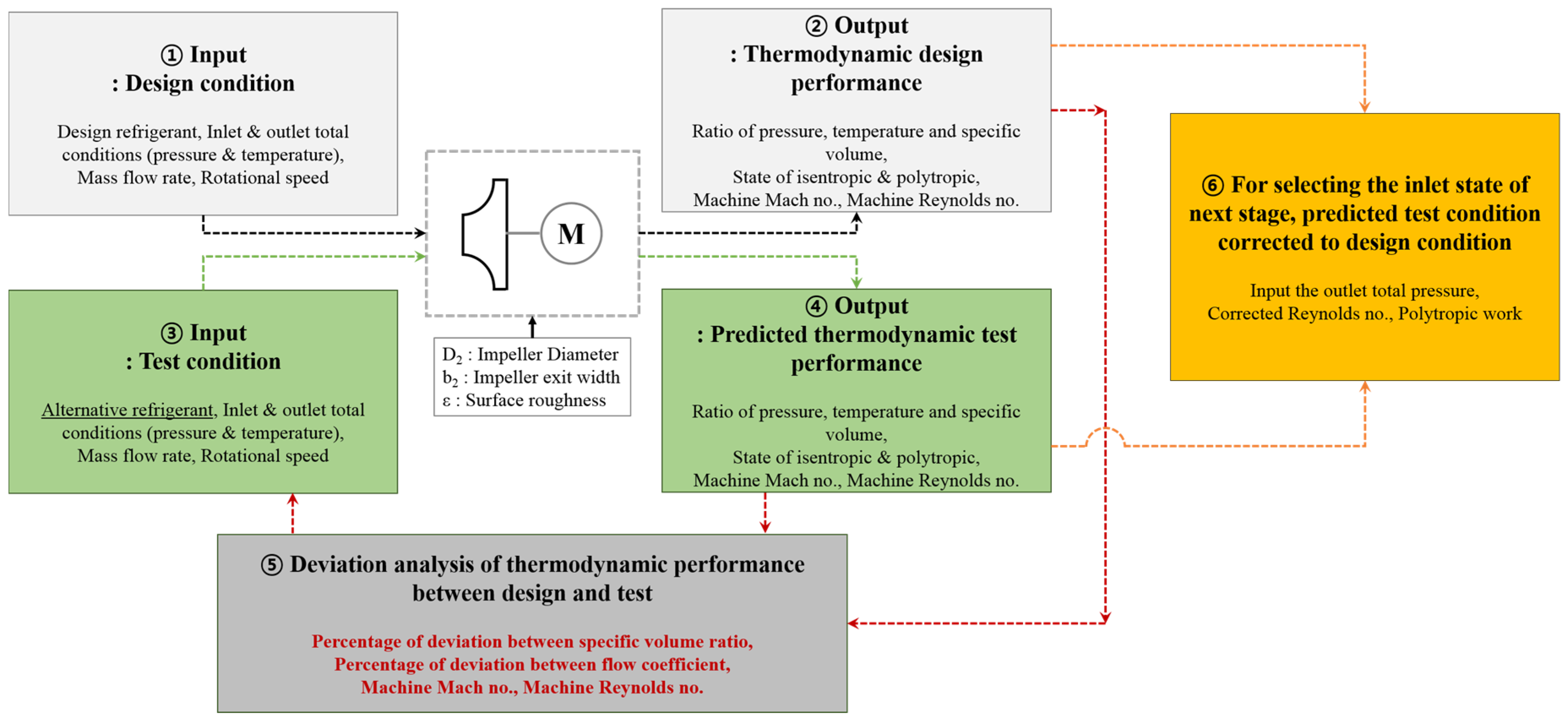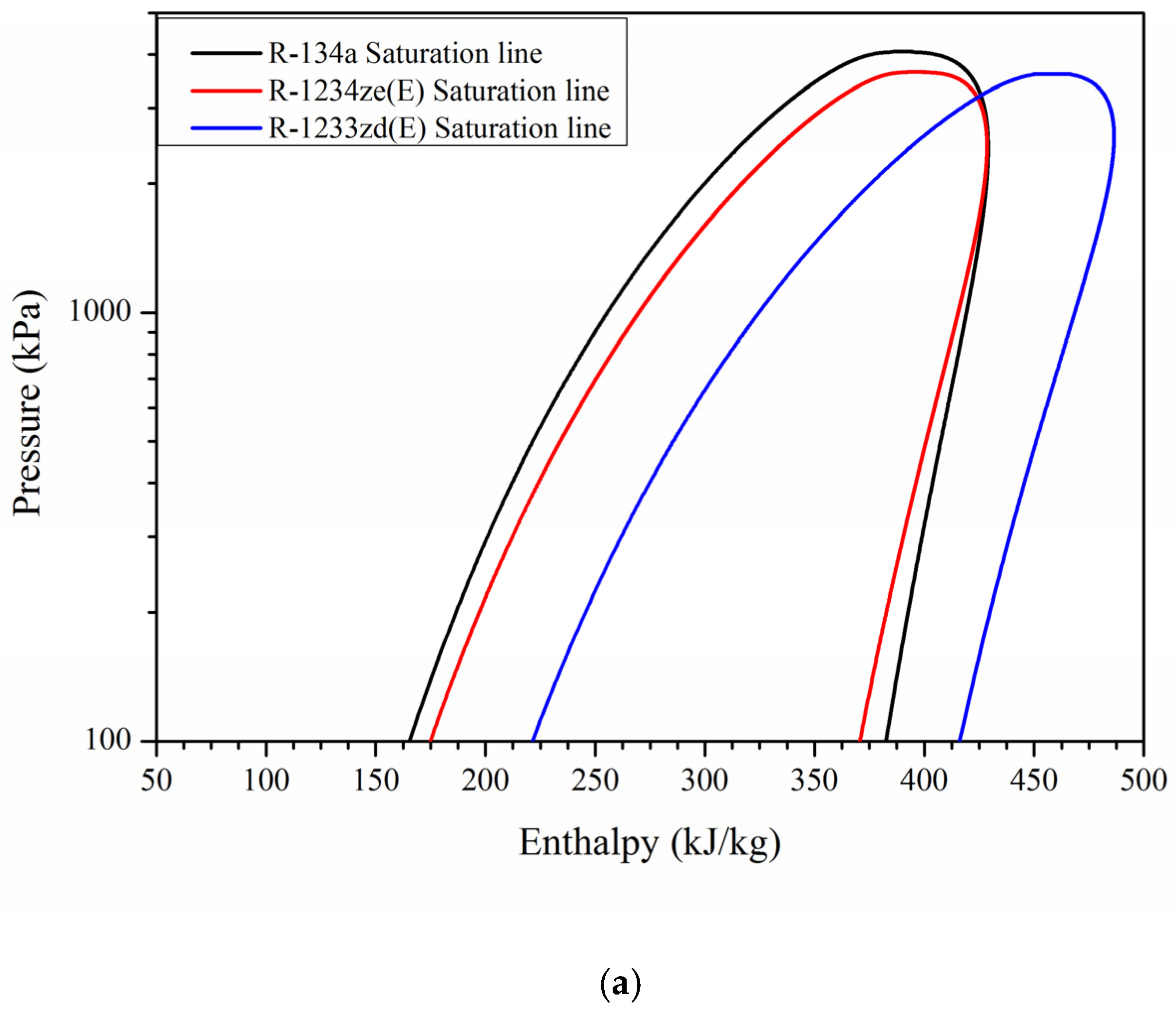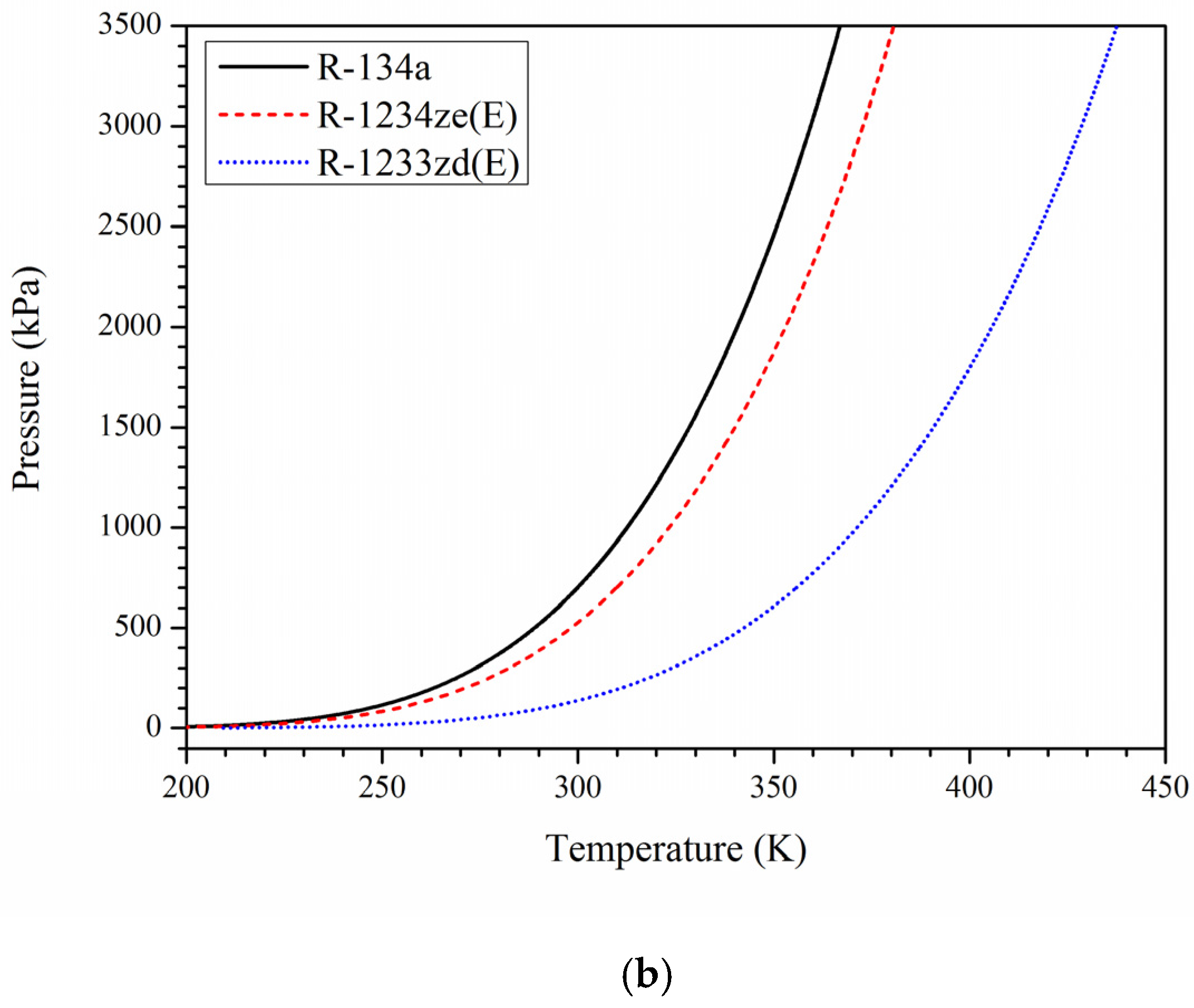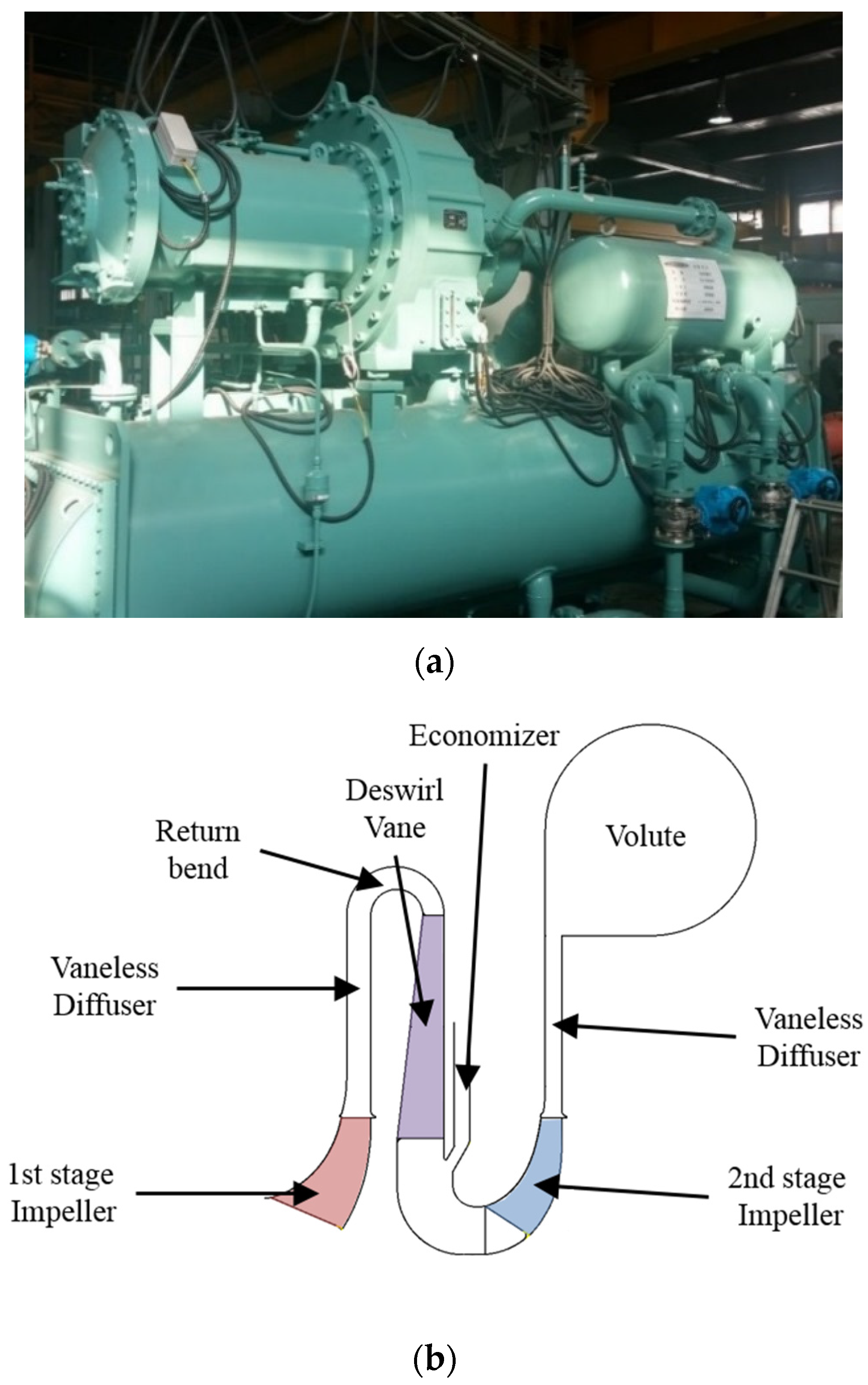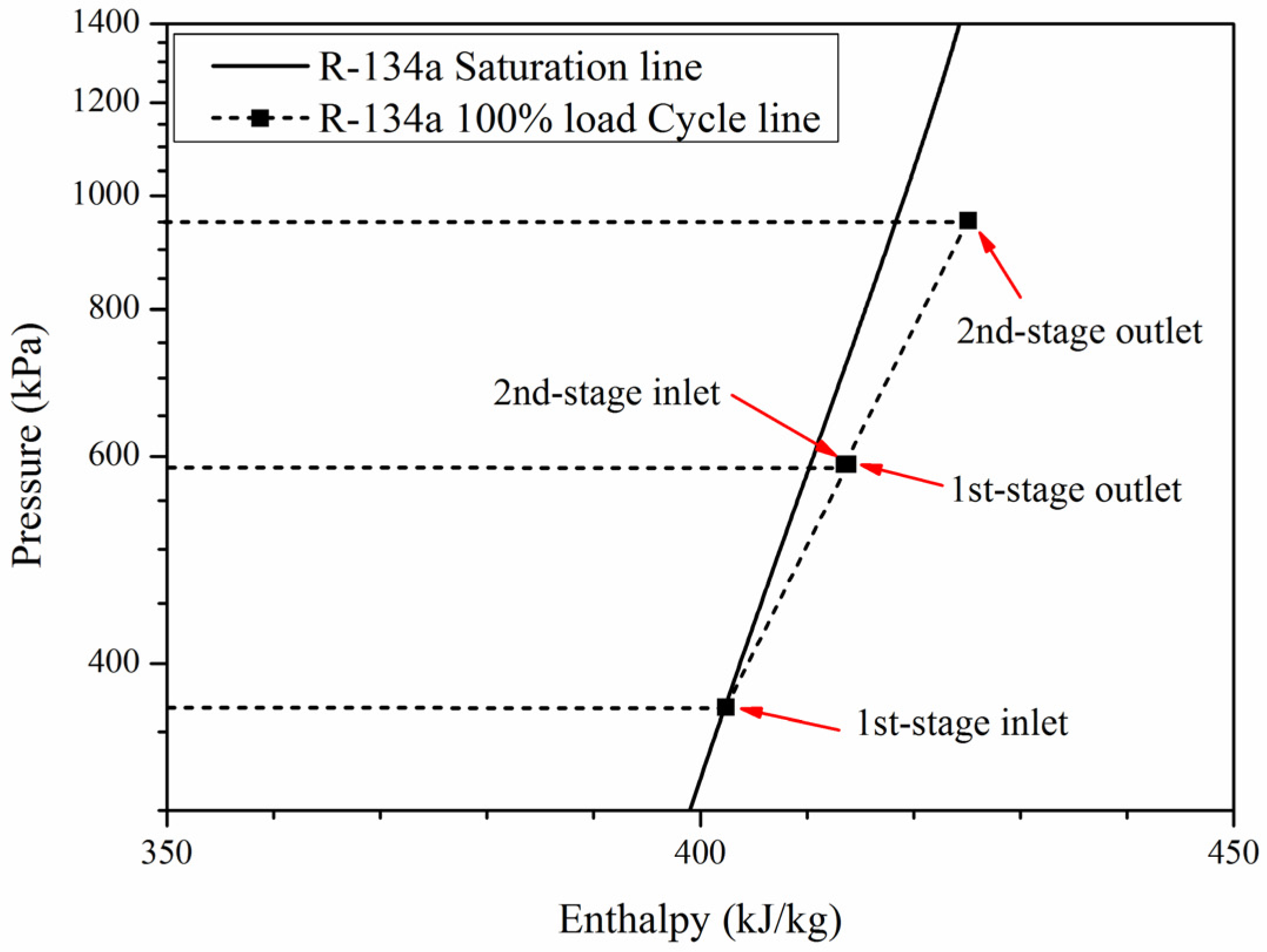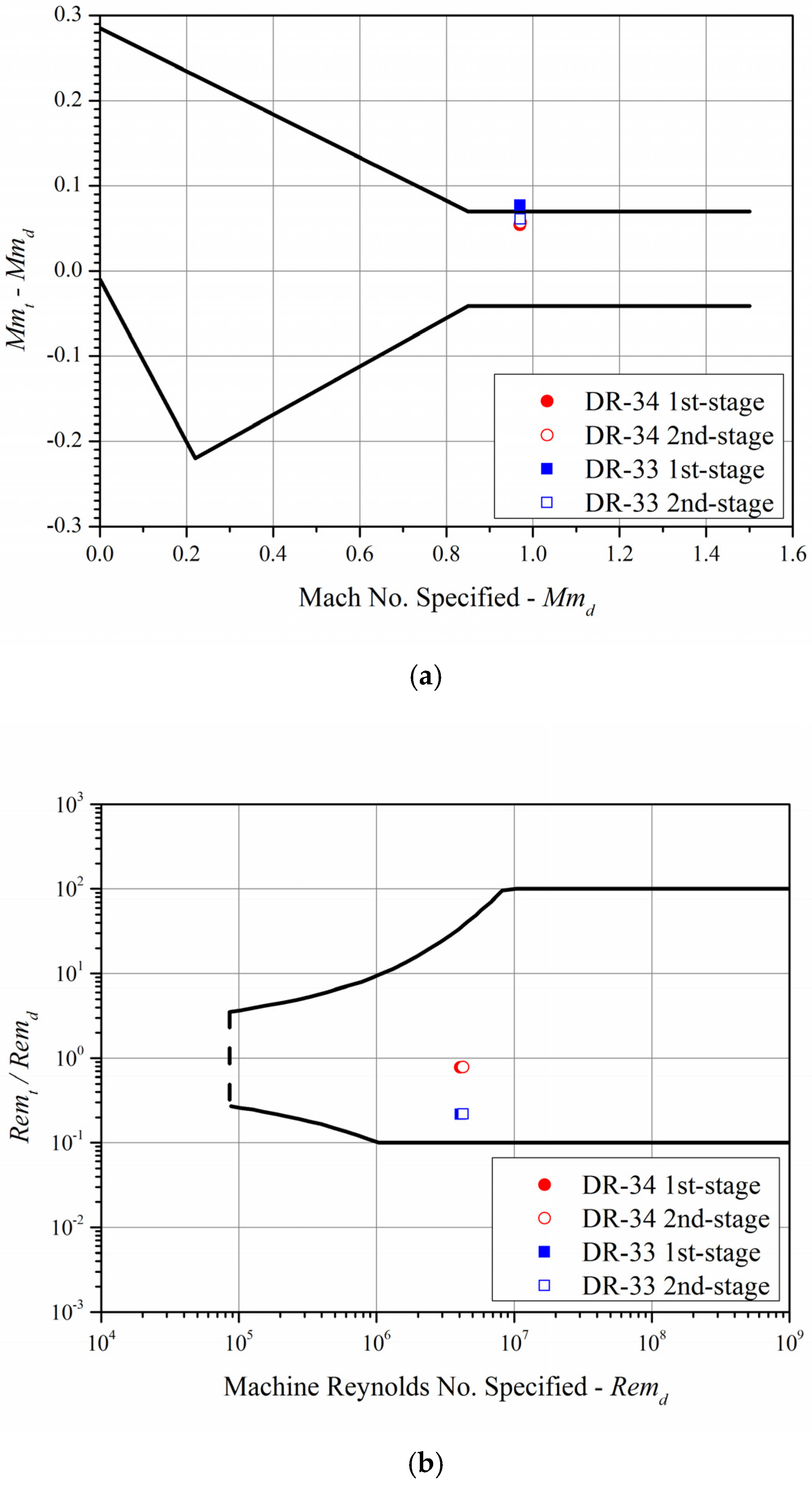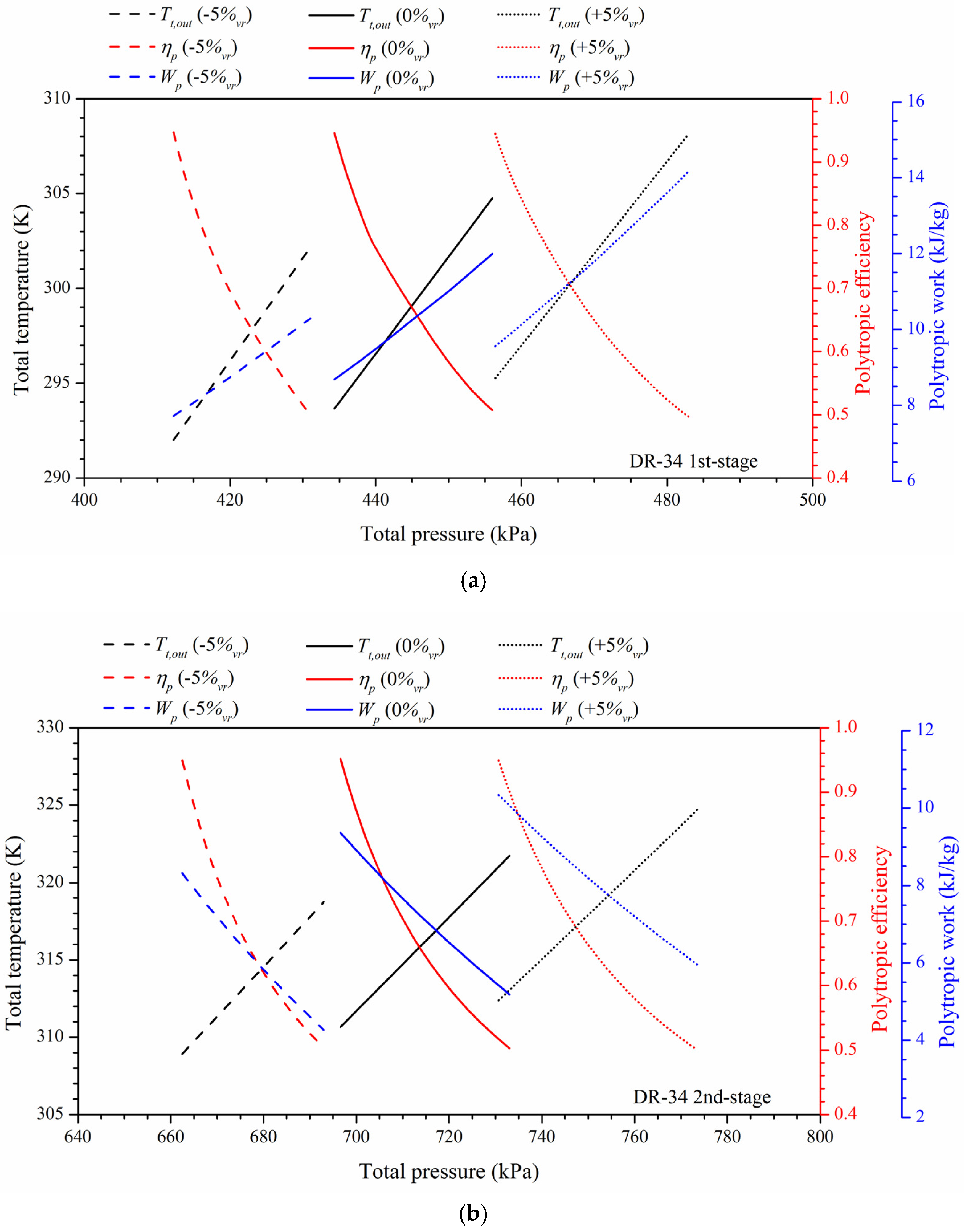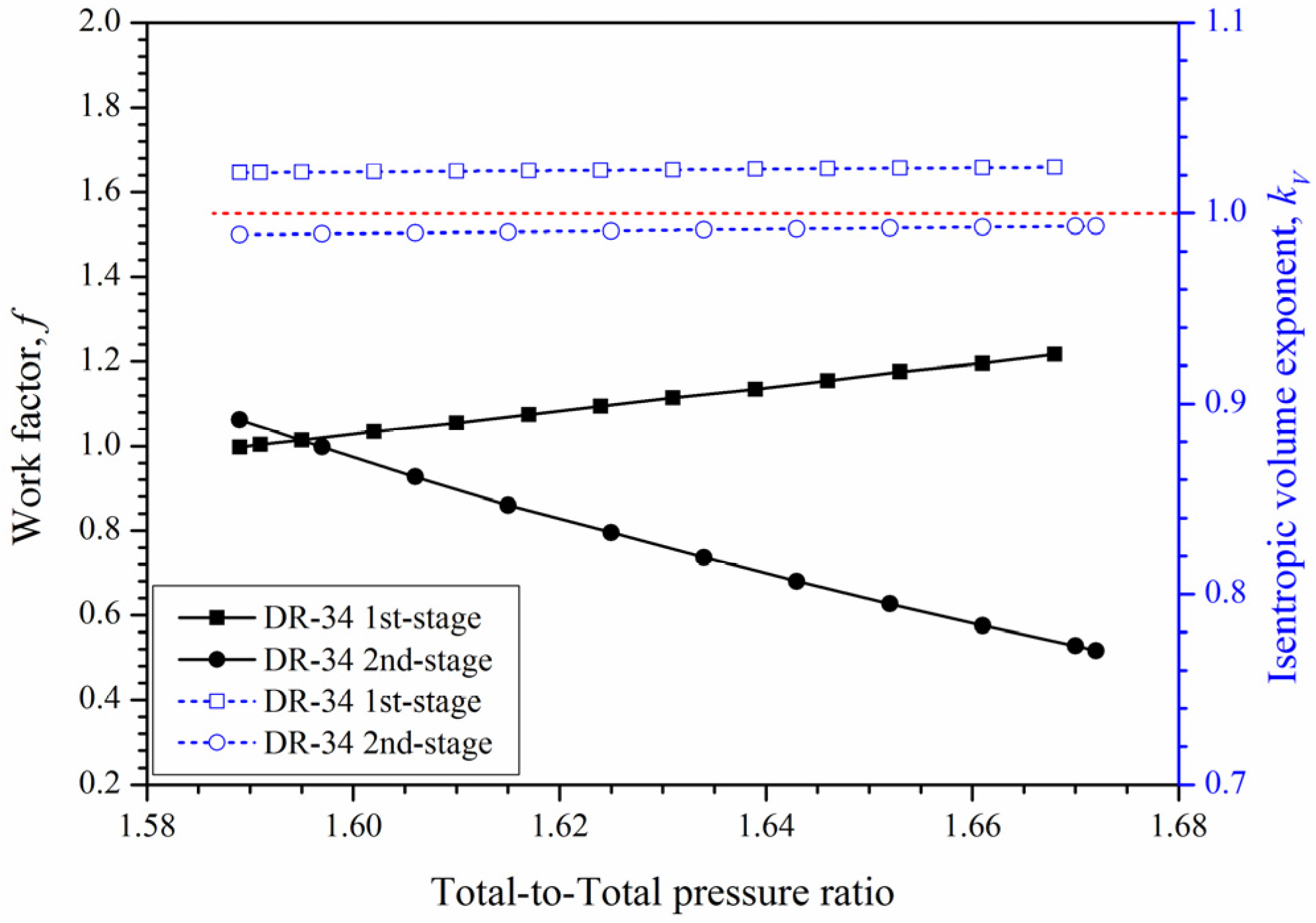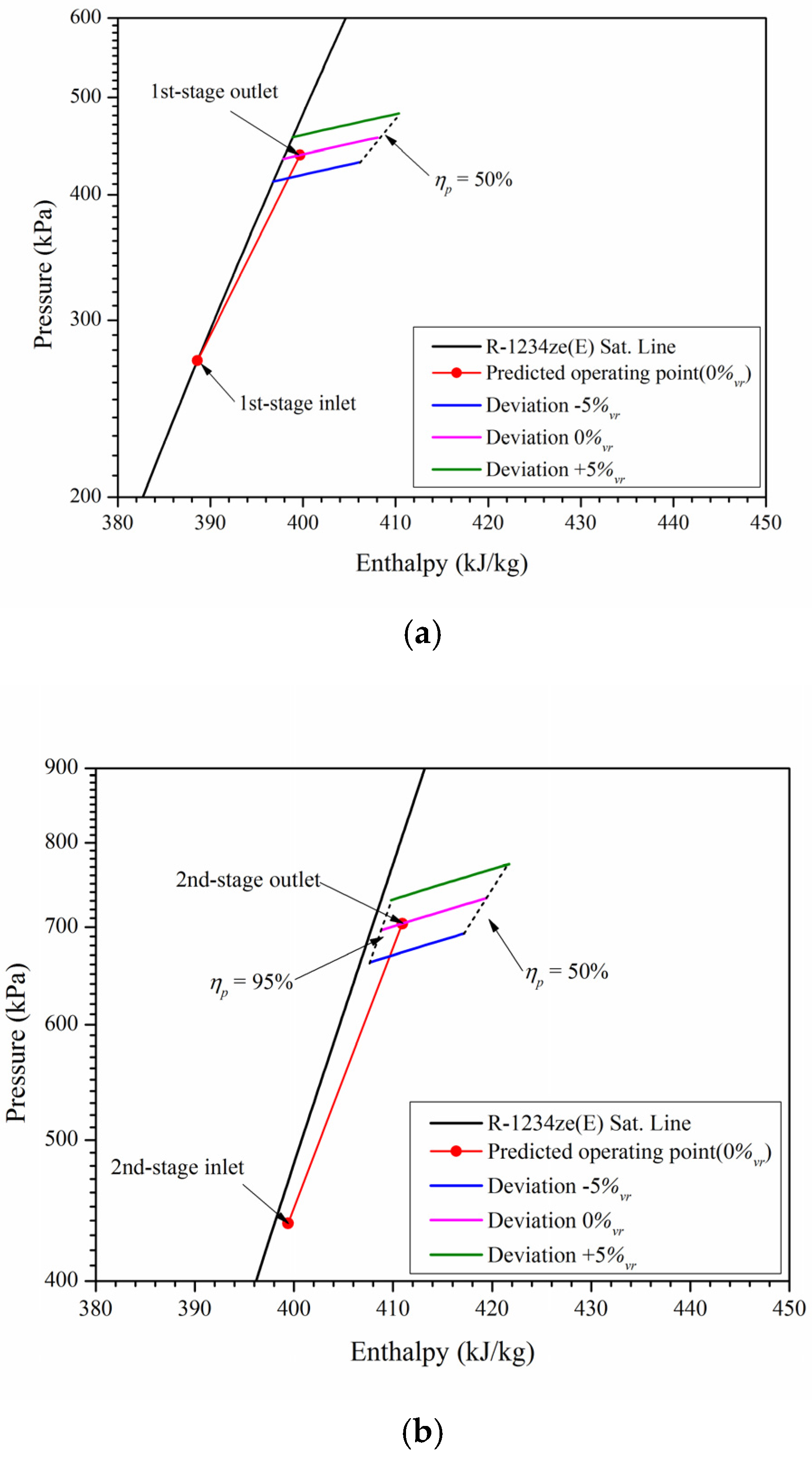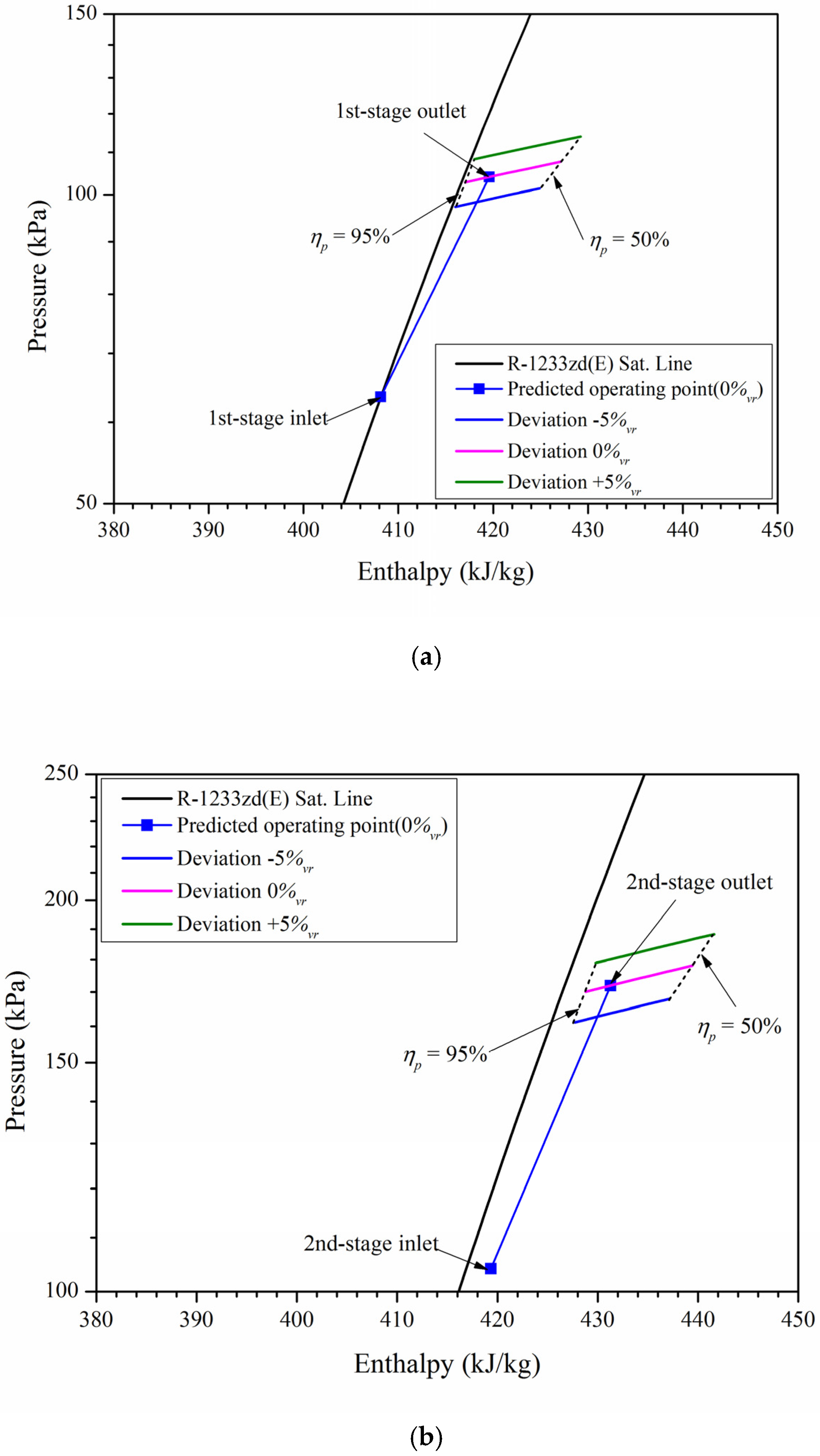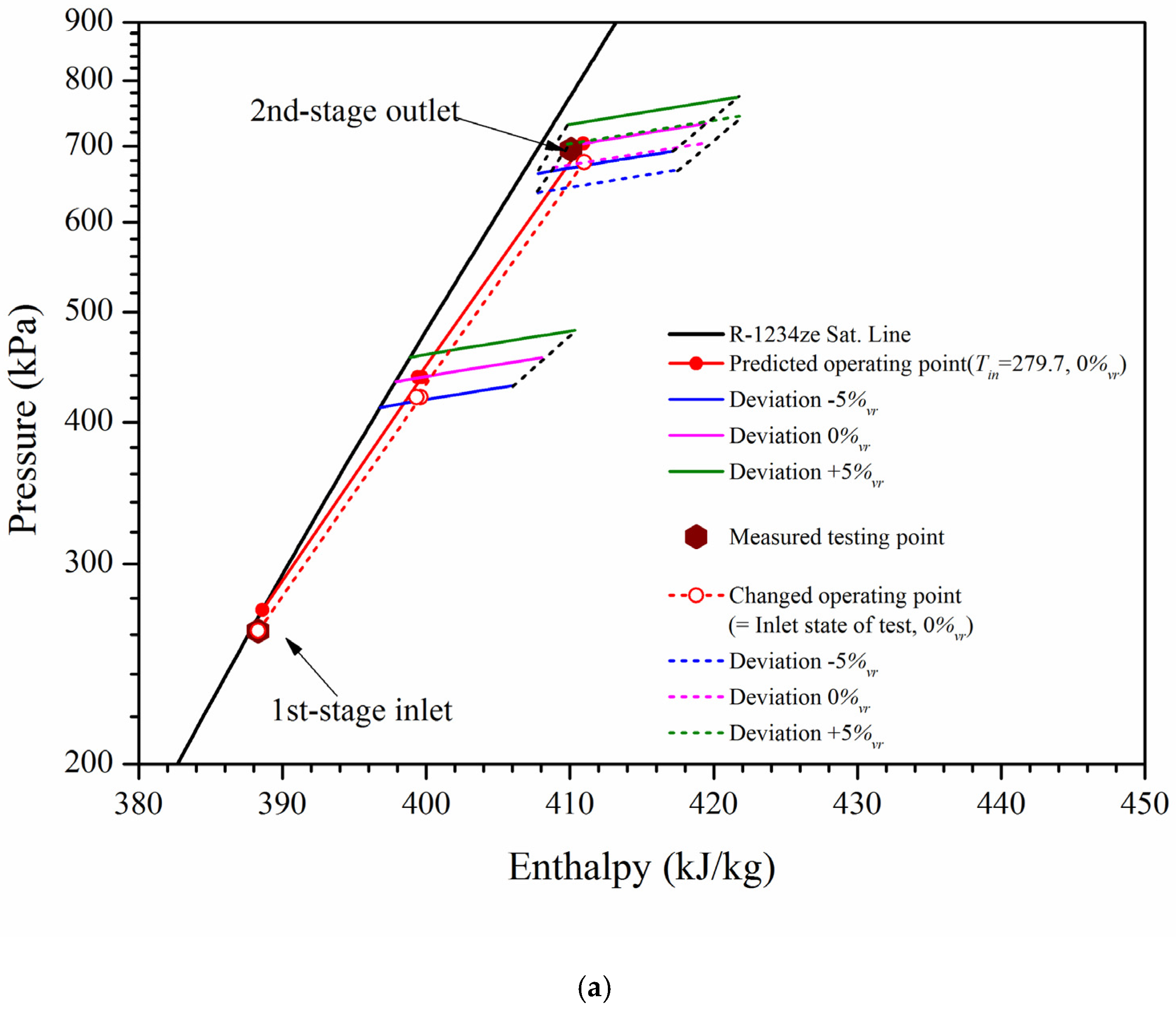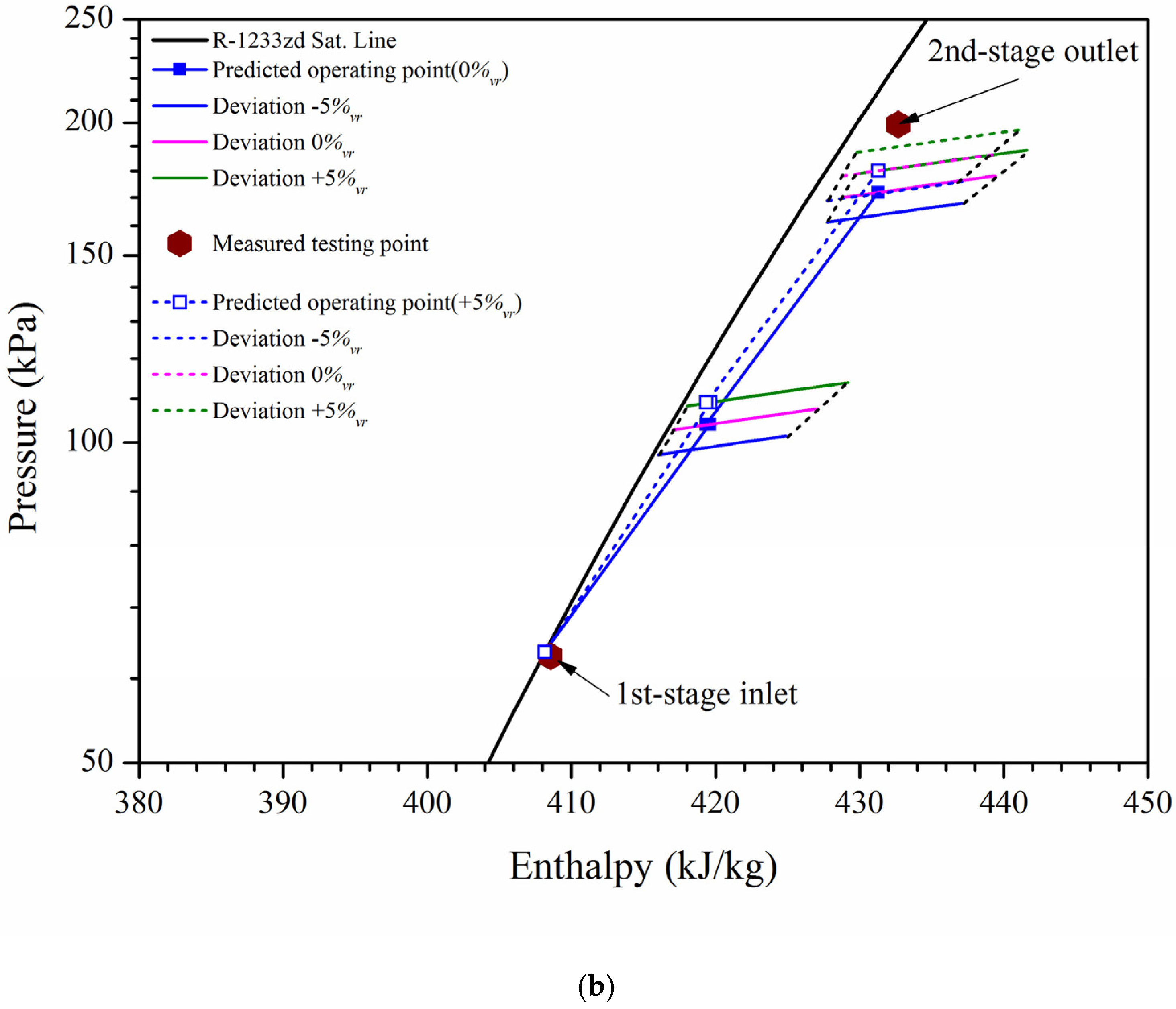1. Introduction
At present, hydrofluorocarbon (HFC)-series refrigerants are the main working refrigerants used in turbo chillers. Since such refrigerants have a high global warming potential (GWP), their use is being phased out worldwide. Refrigerants that have little or no effect on global warming have been continuously developed to replace the existing high-GWP refrigerants. Low-GWP refrigerants include hydrocarbon-based refrigerants, natural refrigerants, and hydrofluoroolefin (HFO)-based refrigerants. Of these, HFO-based refrigerants, R-1234yf, R-1234ze (E), R-1233zd (E), and R-1336mzz, are attracting attention as new alternative refrigerants owing to their low-GWP characteristics and compatibility with existing turbo chiller refrigerants. These alternative refrigerants have been subjected to drop-in tests in existing facilities for applicability and thermodynamic evaluation. In this regard, studies using HFO-based low-GWP alternative refrigerants have been conducted in various ways.
Wang et al. [
1] introduced the Air-Conditioning, Heating, and Refrigeration Institute (AHRI)’s Low-GWP Alternative Refrigerant Evaluation Program (Low-GWP AREP) and outlined the overall scope and procedures of the program. In addition, for the low-GWP candidate refrigerants, they provided the cycle count up to the current state and the actual test result.
Spatz et al. [
2] analysed the theoretical performance of several low-GWP refrigerants in a volumetric chiller and centrifugal chiller used for air conditioning. The centrifugal chiller is divided into a low-pressure chiller using R-123 and a medium-pressure chiller using R-134a. The rotational speed, impeller outlet diameter, and coefficient of performance (COP) of the compressor were compared to those of conventional high-GWP refrigerants, and the results were analysed. This study showed that these refrigerants could be applied to existing devices without significant hardware modifications.
Ueda et al. [
3] performed a drop-in test of the R-1234ze (E) alternative refrigerant in an R-134a centrifugal chiller. They analysed the compatibility of products related to lubrication and the performance of the chiller via full- and partial-load refrigerator tests. The results of the drop-in test under full load conditions showed that the cooling capacity and COP were reduced by approximately 29% and 3%, respectively, at the same inlet volumetric flow rate.
Brasz [
4] predicted the capacity and performance of a centrifugal compressor using an ideal cycle and a thermodynamic property calculation for R-1234ze (E). In the study, R-1234ze (E) was injected into an existing R-134a centrifugal compressor to compare the aerodynamic performance with rotational speed. The author found that, when using alternative refrigerants, the efficiency of the chiller increased because of the low rotational speed and viscous loss compared to conventional centrifugal compressors, which are larger than the centrifugal compressor used in the conventional chiller. However, it was suggested that a condenser redesign is necessary to prevent a pressure drop from the condenser.
Pearson [
5] analysed the method and characteristics of R-134a for alternative refrigerants and explained the primary issues to consider in alternative-refrigerant centrifugal compressor and chiller design. The performance of the developed centrifugal compressor was compared and analysed with the COP of R-134a, and R-1234ze (E) was found to be a viable alternative to the existing R-134a centrifugal compressor.
Mota-Babiloni et al. [
6] performed a drop-in test of two alternative refrigerants (R-1234yf and R-1234ze (E)) in an R-134a vapor compression plant. It was confirmed that the volume efficiency, cooling capacity, and COP were decreased compared with those of R-134a, and the use of an internal heat exchanger could reduce the COP difference between alternative refrigerants.
Wu and Thilges [
7] experimentally analysed the performance of one centrifugal compressor with three alternative refrigerants for various types of refrigerators with R-123 as the working fluid. The effects of the isentropic exponent, Reynolds number, blade Mach number, impeller diameter, rotational speed, etc. were studied.
Janković et al. [
8] analysed the performance of the system and the heat transfer characteristics of a condenser when R-1234yf and R-1234ze (E) were applied to the simulation model of an R-134a small-power refrigeration system, considering the actual dimensions. The authors concluded that R-1234ze (E) could perform better than R-1234yf as an alternative refrigerant for R-134a if an overridden compressor with a cooling system could be used.
Meng et al. [
9] showed the theoretical performance of three mixed gases consisting of R-1234ze (E), R-152a, and R-1234ze (E) mixed with R-152a, respectively, in drop-in tests. The COP of the R-1234ze (E) mixture was similar to that of R-134a, but the cooling capacity was significantly lower. They also showed that a refrigerant composed of R-1234ze (E) and R-152a with a mixing ratio of 50:50 would be suitable as an alternative refrigerant for R-134a.
Sethi et al. [
10] analysed the theoretical performance when replacing R-447B and R-452B with a domestic reversible heat pump and a direct-expansion air-cooled chiller using R-410A. For the R-410A positive displacement chiller, the expected operating conditions of the components were analysed with the alternative refrigerants. In addition, the size and performance of the centrifugal compressors based on alternative refrigerants such as R-515A, R-1234ze (E), and R-1234yf were theoretically analysed for use in R-134a centrifugal chillers.
To summarize the previous studies to date, studies using low-GWP refrigerants have mainly focused on heat exchangers, heat pumps, and thermodynamic cycle analyses. In recent years, some companies have developed centrifugal chillers [
11,
12] and centrifugal compressors [
13] that use a low-GWP alternative refrigerant as the operating gas. However, studies on the characteristics of a centrifugal compressor alone using a low-GWP alternative refrigerant have not yet been published. In particular, when it is difficult to supply alternative refrigerants, a method to predict the performance of the centrifugal compressor in advance would be very useful. In addition, it is necessary to evaluate and analyse the performance of centrifugal compressors when using a substitute gas.
In this study, two low-GWP alternative refrigerants, R-1234ze (E) and R-1233zd (E), were applied to an R-134a centrifugal compressor with a two-stage turbo chiller. Then, the operating area and operating point of the centrifugal compressor were predicted via a drop-in test. The existing centrifugal compressor performance test code was improved, and the expected performance of a centrifugal compressor using an alternative refrigerant was calculated and thermodynamically analysed. Although R-1233zd (E) is a low-pressure refrigerant, it was used to examine the feasibility of the proposed performance prediction method.
2. Centrifugal Compressor Performance Prediction Method
AHRI provides an evaluation program for drop-in testing using low-GWP alternative refrigerants [
14]. Based on this program, the centrifugal compressor test is applied according to The American Society of Mechanical Engineers, Performance Test Code-10 (ASME PTC-10) [
15]. ASME PTC-10 provides a performance test procedure and the permissible deviation required for thermodynamic evaluation of the centrifugal compressor and axial compressor.
The ASME PTC-10 performance tests are classified into two types, type 1 and type 2, depending on the test gas. The type 1 method is used when the components of the design gas and test gas are the same or similar. The type 2 method is used when the components of the design gas and test gas are different. In both types of tests, the performance of the centrifugal compressor is compared with the design performance, and the feasibility of the result is thermodynamically evaluated. However, for each type of test result, there is a difference between the design performance, the type of comparison variable, and the permissible deviation. For a multi-stage compressor, the performance is evaluated using information about the operating conditions of the inlet and outlet (inlet duct and outlet duct) of the compressor, the impeller outlet diameter at each stage, and the impeller outlet width at the first stage. Here, the mass flow rate at the inlet and outlet should be the same.
In this study, we used the ASME PTC-10 type 2 method for predicting performance and improved the method to calculate the expected operating range and the expected performance of the centrifugal compressor using an alternative refrigerant. Performance prediction was conducted for each stage.
2.1. Performance Prediction Procedure
Figure 1 shows the performance prediction process using an alternative refrigerant. The impeller diameter, impeller outlet width, and surface roughness of the impeller remain constant because the centrifugal compressor’s shape does not vary with the type of refrigerant used. The performance prediction process using alternative refrigerants is as follows:
STEP-1: Enter information about the design conditions. The required information includes the name of the design refrigerant, the total pressure and total temperature of the inlet and outlet, the mass flow rate, and the rotational speed.
STEP-2: Calculate thermodynamic performance based on the design conditions. These conditions include the total pressure ratio, total temperature ratio, ratio of inlet and outlet specific volumes, isentropic and polytropic states, machine Mach number (defined in Equation (3)), machine Reynolds number (defined Equation (4)), and so on.
STEP-3: Enter information about the expected test conditions. This input information is similar to the design conditions. The name of the selected alternative refrigerant is entered as the test operation refrigerant.
STEP-4: Calculate thermodynamic performance based on the expected test conditions. The items to be calculated are the same as those in STEP-2.
STEP-5: Compare the following four results obtained from STEP-2 and STEP-4: ratio of inlet and outlet specific volumes, flow coefficient, machine Mach number, and machine Reynolds number. The expected operation range of the drop-in test is calculated based on the design result (STEP-2). The allowable deviation in the operation range is calculated based on the type-2 ASME PTC-10 criteria.
STEP-6: Select the expected operating point that meets the design result in the expected operation range derived in STEP-5. The expected operating point is selected after comparison with the design results via the correction process. The outlet temperature and pressure of the selected operating point are reflected in the inlet conditions of the next connected stage.
Table 1 shows the permissible deviation range required for performance prediction. The calculation formulas for each comparison variable are as follows:
where,
%vr is the percentage of deviation between specific volume ratios,
vr is specific volume ratio,
Φ is the flow coefficient,
Mm is the machine Mach number,
Uimp,out (m/s) is tangential speed at the impeller outlet,
ain (m/s) is the acoustic velocity,
Rem is the machine Reynolds number,
bimp,out is the impeller outlet width,
νin (m
2/s) is the kinematic viscosity,
μin (kg/m·s) is the absolute viscosity, and
vin (m
3/kg) is the specific volume. The subscript
in signifies a specific point of the inlet duct.
Figure 2a,b show the minimum and maximum deviation ranges for the design conditions and test conditions, respectively, as the permissible range of the machine Mach number and machine Reynolds number. The minimum machine Reynolds number in
Figure 2b is greater than 90,000 [
15].
In ASME PTC-10, the performance of a centrifugal compressor is evaluated with the polytropic method. Because the operating refrigerant and alternative refrigerant are all real gases, the method proposed by Schultz [
16] is used to calculate the polytropic parameters for a real gas.
2.2. Calculation of Polytropic Exponents
The polytropic exponents for a real gas can be calculated using the compressibility function proposed by Schultz. The Schultz compressibility functions
X and
Y are:
Here, the Schultz compressibility functions
X and
Y can be calculated by converting the volume expansivity calculated using Equation (7) and the isothermal bulk modulus calculated using Equation (8) into Equations (9) and (10), respectively:
where
α (1/
K) is the volume expansivity and
KT (kPa) is the isothermal bulk modulus. Since the temperature and pressure states are different at the compressor inlet and outlet, the compressibility function at the compressor inlet and outlet are averaged and then used.
Xm and
Ym, calculated using Equations (11) and (12), respectively, are used to calculate the polytropic volume exponent,
n, and polytropic temperature exponent,
m. The polytropic exponents are given by Equations (13) and (14) [
17]. Equation (15) gives the isentropic volume exponent (
kv) used to obtain the polytropic temperature exponent:
where
ηp is polytropic efficiency and
vis,out (m
3/kg) is the specific volume at the outlet duct in the isentropic state.
2.3. Calculation of Polytropic State
In this study, the method proposed by ISO 5389 [
17] was used to calculate the polytropic efficiency of a centrifugal compressor. The formula for calculating the polytropic efficiency is given by Equation (16) using the compressibility functions
X and
Y proposed by Schultz. To evaluate the thermodynamic performance of the centrifugal compressor according to the operating point, we can calculate the polytropic work
Wp (N·m/kg) and gas power
Pg (kW) using Equations (17) and (18). Equation (19) gives Schultz’s work factor,
f, for calculating polytropic work [
16]:
where
R (N·m/kg·K) is the gas constant,
Zin is the compressibility factor of the refrigerant at the inlet duct,
(kg/s) is the mass flow rate, and
h is the enthalpy at a specific point.
2.4. Correction and Selection Method for the Drop-In Test’s Expected Operating Point
For a single-shaft multi-stage centrifugal compressor connected to the return channel, the outlet pressure of the return channel is designed to equalize the inlet pressure of the next stage connected. Therefore, an appropriate predicted operating point should be selected as the entry state of the next stage among the calculated expected operation areas. STEP-6 in
Figure 1 is the step in which an expected operating point is selected based on the predicted operating area. In this step, the design performance is corrected using the results of the predicted driving range. The predicted operating point of the drop-in test was selected when the polytropic work value of the calculated correction was equal to the polytropic work of the design performance. If the value of the polytropic work of the correction result is greater or less than the design performance value, the outlet temperature and pressure of the predicted operating point can be adjusted. To correct the expected operating point of the drop-in test to match the design performance, the following equations are sequentially calculated:
where
Q (m
3/s) is the volume flow rate at the inlet.
RA,
RB, and
RC are machine Reynolds number correction constant constants. The subscript
corr signifies the corrected state.
2.5. Thermodynamic Properties of Refrigerants
The thermodynamic properties of all refrigerants used for performance prediction were obtained from NIST REFPROP 9.1 [
18]. However, those of R-1234ze (E) and R-1233zd (E) were obtained from the file uploaded to the FAQ of NIST REFPROP [
19]. The refrigerant state equation is the Helmholtz equation of state recommended by NIST [
20]. Microsoft Excel was used for performance prediction, and it was possible to acquire the state quantity of the refrigerant in conjunction with the REFPROP data.
6. Conclusions
In this study, a low-GWP alternative refrigerant was used in the centrifugal compressor of a conventional R-134a turbo chiller, and the performance of the centrifugal compressor in each stage, which is required for the drop-in test, was predicted. A performance prediction method was proposed by changing the existing performance test code, and the predicted operating range and operating point were calculated using the proposed method. The following conclusions were obtained from this study.
Polytropic work, which is one of the thermodynamic performance variables of a centrifugal compressor, was found to be affected by the isentropic volume exponent value. In the predicted operating ranges of DR-34 and DR-33, the temperature difference between the deviations of the specific volume ratios was approximately 3 K at 95% polytropic efficiency and approximately 6 K or less at 50% polytropic efficiency. This shows that the predicted operating range calculated based on the permissible deviation of ASME PTC-10 is sensitive to temperature at the same efficiency point. The predicted operating range of DR-33 was small because the pressure difference between the deviations of the specific volume ratio was smaller than that of DR-34.
The predicted operating point at the stage-two outlet of DR-34 was higher by approximately 1.2% than that of the drop-in test. If the operating point was predicted by changing the stage-one inlet condition to the test result, the pressure at the stage-two outlet was lower by approximately 2.6% compared to the measured value. Although there was a quantitative deviation between the measured and predicted operating points because the test result was in the predicted operating ranges for the two conditions, the proposed method predicted the operating range of DR-34 well.
In the case of DR-33, the predicted operating point and operating range were generally lower than the test results. A more accurate evaluation requires additional analysis based on the off-design points of R-134a and thermodynamic influence of the heat exchanger.
In this study, we proposed a performance prediction method that can be used to predict the operating range and operating point of the drop-in test of alternative gases by using the performance test code of an existing centrifugal compressor. The proposed method can be used to predict and evaluate the performance in each stage of a multi-stage centrifugal compressor. The results proved that the performance of a centrifugal compressor can be predicted when operated with an alternative gas based on limited information about factors such as design conditions and shapes.
Furthermore, additional information about the off-design points of a centrifugal compressor will be helpful for identifying the predicted operating range and operating point more precisely.
